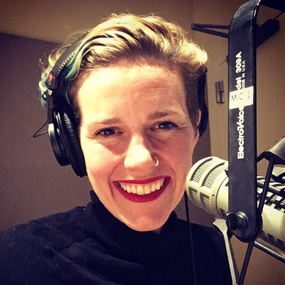

Join BirdNote tomorrow, November 30th!
Illustrator David Sibley and actor H. Jon Benjamin will face off in the bird illustration battle of the century during BirdNote's Year-end Celebration and Auction!
Wilson Wewa, an elder of the Northern Paiute tribe of the Warm Springs Reservation in Oregon, remembers the first time he saw a sage-grouse lek … hearing their otherworldly sound. “As a little boy of about five or six years old, I got scared!” Wewa says. “I didn’t know what it was.”
[Hear more stories from Wilson Wewa on Grouse from BirdNote Presents]
BirdNote®
Wewa and the Grouse
Written by Ashley Ahearn
Ashley Ahearn: This is BirdNote.
Sage-grouse populations are declining across the West. The birds are known for their ornate displays at mating sites — or "leks," as they’re called.
Wilson Wewa, an elder of the Northern Paiute tribe of the Warm Springs Reservation in Oregon, remembers the first time he saw a sage-grouse lek:
Wilson Wewa: My grandpa and I went to get some water from the spring. And he heard … we heard that fluttering sound, kind of like a popping noise.
[Sage grouse sounds]
And as a little boy of about five or six years old, I got scared… I didn’t know what it was. But we went through that sagebrush and then we got to a place where we had a good vantage point. And we seen the sage hens doing their dance.
Ashley Ahearn: The Northern Paiute and other tribes in sagebrush country have stories, legends and dances about the sage-grouse. The birds once numbered in the millions, before European explorers and settlers arrived and the birds’ habitat came under threat.
Wilson Wewa: If they don't have the right kind of environment, they will disappear. What happens to them is what will happen to us as people.
Ashley Ahearn: You can hear more stories from Wilson Wewa on our new series Grouse. Subscribe to BirdNote Presents in your podcast app, or listen at BirdNote.org. I’m Ashley Ahearn.
###
Sounds recorded by Ashley Ahearn
Producer: John Kessler
Production Manager: Allison Wilson
Editor: Ashley Ahearn
Producer: Mark Bramhill
Associate Producer: Ellen Blackstone
BirdNote’s theme was composed and played by Nancy Rumbel and John Kessler.
© 2020 BirdNote October 2020 Narrator: Ashley Ahearn
ID# GRSG-07-2020-10-06 GRSG-07





